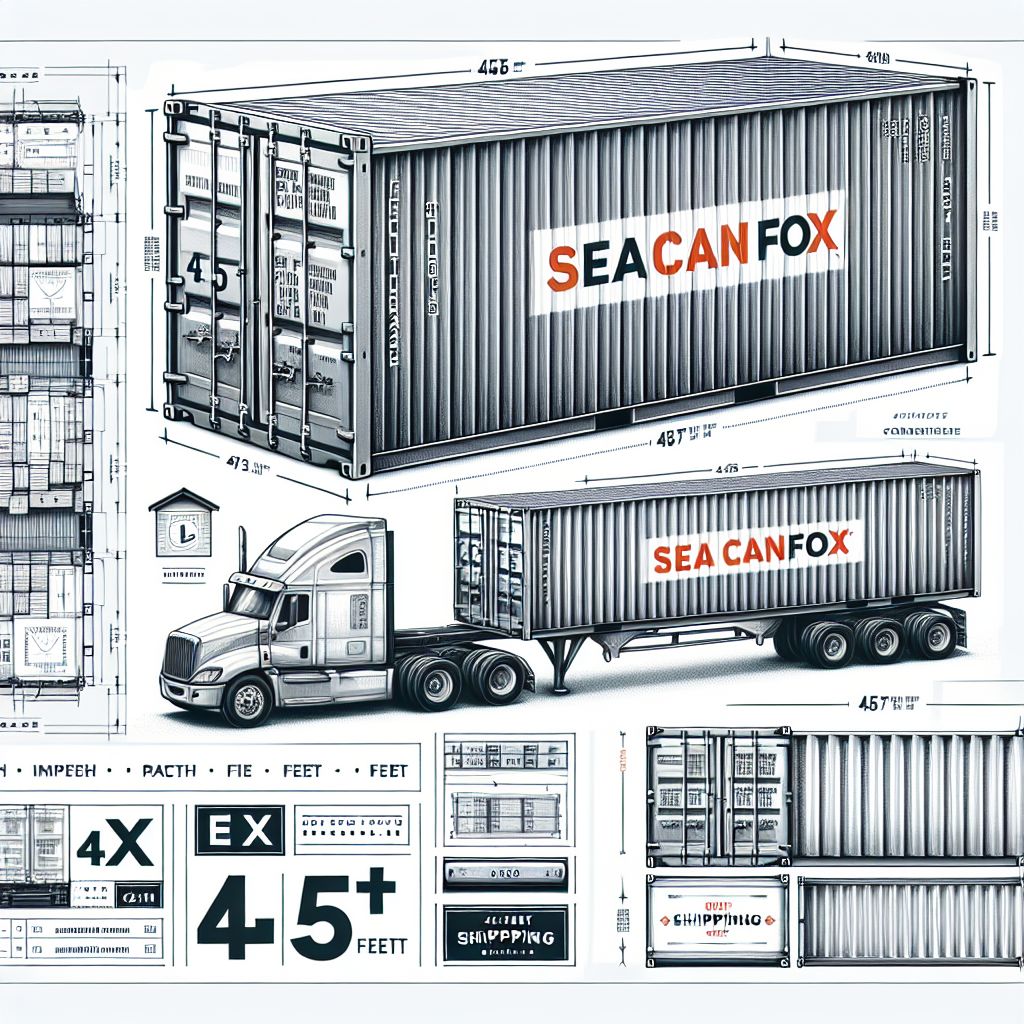
Key Takeaways
- A 45ft (13.72m) shipping container typically measures 45 feet (13.72m) length, 8 feet (2.44m) width, and 9.5 feet (2.90m) height externally.
- The internal dimensions are slightly less due to the thickness of the walls – 44.42 feet (13.54m) length, 7.64 feet (2.33m) width, and 8.73 feet (2.66m) height’
- Its usable volume is about 86 cubic meters (3,037 cubic feet).
- The net weight (tare weight) of the container is around 4,800 kg (10,582 pounds), with a maximum payload capacity of approximately 25,680 kg (56,604 pounds).
When you’re in the business of moving goods across the world, you’ll hear a lot about containers. But it’s not just any container we’re talking about—it’s the 45ft shipping container, a giant in the world of logistics. It’s like the big brother of the container family, and it’s got a lot of room to pack in just about anything you need to ship.
Now, let’s get down to the nitty-gritty. The 45ft container is not just longer than its 20ft and 40ft cousins; it’s also taller, which means it’s a high-cube container. High-cube means more height, more space, and more stuff you can fit inside. So, if you’ve got a load of furniture, a mountain of boxes, or even something as big as a car, this container is up for the task.
Table of Contents
My Favorite Container Homes Resource
I compared the top 3 Container Home Guides
to discover the ultimate resource!
See my top recommendation here
Maximizing Cargo Efficiency with 45ft Containers
First things first, we need to understand that size matters in shipping. A 45ft container allows you to transport a larger volume of goods in one go. This means fewer trips, which saves time and money, and who doesn’t like saving money, right? But it’s not just about stuffing it to the brim. You’ve got to be smart about it, pack it right, and make sure everything fits snugly so your cargo arrives just as it left.
Digital Age of Logistics: The Role of Container Dimensions
In the digital age, logistics is all about precision. You can track your container as it travels across the sea, but before it sets sail, you need to know if your goods will fit. The dimensions of a 45ft container are key to planning. You wouldn’t want your cargo to arrive at the port only to find out it’s too big to fit. That’s why knowing the exact size, both inside and out, is crucial.
But it’s not just about fitting into the container. It’s also about fitting into the ship, the port, the warehouse, and even the truck that takes it to its final destination. Each step of the journey has its own size limits, and the 45ft container is designed to make sure your goods can glide through each one without a hitch.
Comparative Overview: Selecting the Right Container for Your Cargo
Choosing the right container is like picking the right pair of shoes. You wouldn’t hike a mountain in flip-flops, right? Similarly, you wouldn’t ship small items in a 45ft container. But if you’re moving a house, or shipping a large volume of products, the 45ft container is your go-to. It’s especially good for lightweight but bulky items, because you can fill it up without worrying about the weight limit too soon.
Practical Insights: What These Dimensions Actually Mean
So, what do these dimensions mean for you? They mean you can plan better. You can calculate how many boxes you can stack, how to arrange them, and even how to secure them so they don’t move around. It’s like playing a game of Tetris, but with real boxes, and the prize is getting your cargo to its destination safely and efficiently.
Now, let’s talk about the specifics. The external dimensions are pretty straightforward—45 feet long, 8 feet wide, and 9.5 feet tall. But inside, you’ve got to account for the thickness of the walls, so you lose a bit of space. It’s like when you buy a chocolate bar and the packaging makes it look bigger than it is. But don’t worry, there’s still plenty of room inside.
And let’s not forget the door. It’s your gateway to loading and unloading, and its dimensions are key. You need to make sure whatever you’re shipping can fit through that door. It’s like trying to get a couch through your front door; if it doesn’t fit, you’re going to have a bad time.
Alright, that’s a lot of information to take in. But remember, the more you know about your container’s dimensions and capacity, the smoother your shipping will be. And in the world of logistics, smooth means fast, efficient, and cost-effective. So, let’s dive into the details and make you a shipping expert in no time.

Door to Floor: Analyze Container Entry Points
When loading a container, the door is your first challenge. It’s essential to know the door’s size because this is the bottleneck of your loading process. If your cargo doesn’t fit through the door, it’s game over before you even start. So, let’s make sure everything can get in smoothly.
Imagine the door as the mouth of a giant. It’s big, but it’s not unlimited. You’ve got to measure your cargo and ensure it can pass through the container’s door. This is particularly important for bulky items that might fit inside the container but struggle to get through the door.
Example: You have a large piece of machinery that’s 7.5 feet wide and 8.5 feet tall. The 45ft container’s door width is usually around 7.8 feet wide and the height about 8.5 feet tall. This means you’ll have to tilt the machinery or find another way to get it inside because it’s a tight fit.
Now, once you’ve tackled the door, you’ve got the entire floor space of the container to work with. But remember, it’s not just about fitting your cargo in; it’s about doing it in a way that maximizes space and minimizes the risk of damage during transit. Think of it like a puzzle – each piece needs to fit perfectly.
Door Dimensions: Calculating Access for Loading
The door dimensions of a 45ft container are crucial. Most doors are about 7.8 feet (2.34 meters) wide and 8.5 feet (2.59 meters) high. This is your maximum size for any single piece of cargo. When planning your load, always keep these dimensions in mind to ensure a smooth loading process. For more details on container sizes and dimensions, refer to this comprehensive size chart.
It’s not just about the width and height, though. The door opening also determines how easily you can use equipment like forklifts for loading. You want to avoid a situation where your forklift barely fits through the door, as this can slow down loading and increase the risk of accidents or damage.
45ft Container Capacity: Understanding Volume and Mass
The usable volume of a 45ft container is like the belly of the beast – it’s where all your goods will reside during their journey. With a capacity of roughly 86 cubic meters, it’s spacious enough to carry a substantial amount of cargo.
Usable Volume: Quantifying Storage Space
Usable volume is the amount of space available inside the container for your cargo. For a 45ft container, this typically measures around 3,037 cubic feet or 86 cubic meters. To put that into perspective, you could fit around 400 standard-sized refrigerators in that space. That’s a lot of fridges!
Maximizing this space is key to cost-effective shipping. It’s like packing a suitcase for a vacation; you want to use every inch of space. The same goes for a shipping container – the more efficiently you pack, the more you save on shipping costs.
Tare Weight and Payload: Balancing the Load
The tare weight is like the container’s own weight without any cargo. For a 45ft container, it’s around 10,580 lbs (4,800 kg). The payload, or how much weight you can actually put inside, goes up to about 56,620 lbs (25,680 kg). It’s like knowing how much weight a truck can carry; you need this info to avoid overloading.
It’s essential to balance the load within the container to ensure safety and avoid overloading. Think of it as a seesaw – too much weight on one end and you’ll have problems. Distribute the weight evenly and secure it properly to prevent shifting during transport.
45ft Container Specifications Table
| Specification | Measurement in Feet | Measurement in Meters |
|---|---|---|
| External Length | 45 | 13.716 |
| External Width | 8 | 2.438 |
| External Height | 9.5 | 2.896 |
| Internal Length | 44.42 | 13.54 |
| Internal Width | 7.64 | 2.33 |
| Internal Height | 8.73 | 2.66 |
| Door Width | 7.8 | 2.34 |
| Door Height | 8.5 | 2.59 |
| Usable Volume | 3,037 cu.ft | 86 cu.m |
| Tare Weight | 10,580 lbs | 4,800 kg |
| Max Payload | 56,620 lbs | 25,680 kg |
References:
- https://www.jingsourcing.com/b-container-sizes-dimensions/
- https://www.icontainers.com/the-different-types-of-containers/
- https://universal-containers.com/news/popular-container-sizes-and-how-to-use-them/
- https://www.discovercontainers.com/shipping-container-dimensions/

Frequently Asked Questions
Why Consider a 45ft Container Over Other Sizes?
There are several reasons why you might opt for a 45ft container. First, it’s about volume. With more space inside, you can ship larger quantities, reducing the number of trips needed. This is not only efficient but also environmentally friendlier. Second, for certain goods, the extra height of a high-cube container is a must-have—it allows for taller items or stacking goods higher.
Furthermore, when shipping large quantities of lightweight goods, you’ll reach the volume limit before the weight limit, making the 45ft container a cost-effective choice. Lastly, for long-distance moves, such as international relocations, the additional space can accommodate more of your belongings, simplifying the process and reducing stress.
For example, if you’re moving your entire home overseas, a 45ft container might be the only size that can comfortably fit all your possessions in one go.
What Types of Cargo Are Best Suited for 45ft Containers?
The types of cargo best suited for 45ft containers are those that are bulky and voluminous. Think of items like furniture, automotive parts, and machinery—goods that need more length and height than what standard containers offer. Because of the extra space, they’re also great for large quantities of palletized goods, textiles, or non-perishable food items.
However, it’s not just about size. The cargo should be relatively lightweight to avoid exceeding weight limits. This is where the 45ft container shines—it allows you to maximize volume without hitting the weight ceiling too quickly.
Can 45ft Containers Be Used for All Modes of Transport?
Yes, 45ft containers are versatile and can be used across different modes of transport—ship, rail, and truck. They are designed to fit on container ships, and most trains and trucks are equipped to handle them. However, it’s important to check with local transport regulations, as some regions might have restrictions on the roads due to the container’s size.
Are There Any Special Requirements for Shipping with a 45ft Container?
When shipping with a 45ft container, you need to be aware of weight restrictions and ensure that your cargo is evenly distributed to avoid imbalances. Additionally, securing your cargo properly is essential to prevent shifting during transit. You should also check the specific requirements of the shipping line, port, and final destination to ensure compliance with all regulations.
How Does Container Size Impact Shipping Costs?
Container size impacts shipping costs in a few ways. Generally, the larger the container, the higher the base shipping rate due to the increased space it occupies on a carrier. However, because you can fit more into a 45ft container, you often end up paying less per unit of cargo, making it more cost-efficient for large shipments.
It’s also worth noting that the availability of 45ft containers can affect pricing. They are less common than 20ft or 40ft containers, which can sometimes make them more expensive to rent or purchase. But the trade-off is the convenience and efficiency they provide for larger shipments.
In conclusion, the 45ft shipping container is a powerhouse in the world of logistics, offering significant space for a variety of cargo types. By understanding its dimensions, capacity, and the implications on logistics operations, you can make informed decisions that save time, money, and resources. Whether you’re a seasoned shipper or new to the field, mastering the use of 45ft containers can give you a competitive edge in the global marketplace.
Remember, it’s not just about getting from point A to point B. It’s about doing it smartly, efficiently, and with the right tools at your disposal. With the knowledge of 45ft shipping container dimensions and capacity, you’re well on your way to optimizing your logistics operations.






Leave a Reply